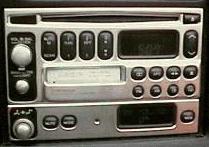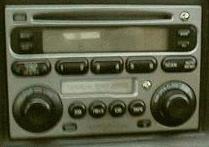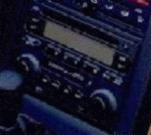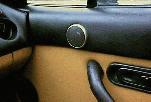MSSS FAQ
V2.7 (December 11, 1998)
Jump To:
General Info
Q) What's a "MSSS" anyway?
A) "MSSS" stands for "Mazda Sensory Sound System". The MSSS was a
premium stereo package and was available on some '93 through '97 Miatas with certain other
packages. The whole MSSS system is Mazda option number RA4. The MSSS is closely related to
the Mazda Premium Sound System or MPSS, option RA5. There were two versions of the MSSS
head unit and one of the MPSS unit. Both premium systems (MSSS and MPSS) have some sound
processing ("wide" and "open/closed"), extra speakers, and a power
antenna. To add to the confusion, the black MPSS head units on some early cars (mostly
'95s) say "Sensory Sound System" just like the MSSS unit! Only the MSSS has a
"thumper" in the seatbacks.
Q) How can I tell if I have an MSSS unit?
A) There were two versions of the MSSS head unit and one of the MPSS unit. I will preface
all the information in this FAQ with the model I am referring to, MSSS1, MSSS2, or MPSS.
- First-Generation Mazda Sensory Sound System (MSSS1)

- Description: The early (first-generation) MSSS head units are bright silver and
are comprised of two separate units as seen in the photo at right. This MSSS stereo has
small knobs on the left side of the unit.
- Markings: The casette/CD unit says "Pioneer AM FM Cassette Combination"
on the cassette door and has the number "6268" on it. The processor is a
separate unit and says "Bodysonic System" and has the number "6V09"
on the lower edge.
- History: These were introduced in '93 and phased out in the middle of '95.
- Availability: The MSSS1 was given the Mazda option code RA4. The MSSS was
standard on the '93 LE cars. It was optional with the A-, B-, and C-packages.
- Second-Generation Mazda Sensory Sound System (MSSS2)

- Description: The later (second-generation) head units are duller silver, almost
gray. They have an integrated casette/CD unit and sound processor. It has two sets of
large concentric knobs near the bottom of the face plate.
- Markings: The head unit says "Sensory Sound System" on it and has the
number, "6269" on it.
- History: These were introduced in '95 and no longer offered as an option on
'97 cars, though some early ones may have this radio. Mazda listed the MSSS as a
phase-out product in '96. None of the '96 brochures mention the MSSS at all.
- Availability: The MSSS2 was also given the Mazda option code, RA4. It was
optional on C- and Leather-Package cars. It was not available on the '95M because its
special seats could not accomodate the thumpers or the headrest speakers. Instead, it
had the standard AM/FM/Casette radio and a separate CD player.
- Mazda Premium Sound System (MPSS)

- Description: The MPSS radio was Mazda's other premium stereo. It is a one-piece
unit and looks just like a second-generation MSSS head unit except that it is black and
does not have controls for the "bodysonic" transducer in the seats.
- Markings: The number, "6270", is on the face. The head unit on early
units still says "Sensory Sound System" even though it is not a MSSS.
- History: The MPSS was introduced in the '95 model year and were quite popular
through '97.
- Availability: The MPSS was given the Mazda option code RA5. It was available
with the Leather- and Popular Equipment-Package. The MPSS was standard on the '96 and
'97 M-Edition cars.
- Commonalities

- All factory MSSS systems have door tweeters with silver rims, headrest speakers, and
seatback transducers ("thumpers") in addition to the standard door speakers and a power
antenna. The MPSS is equipped the same except it has no seatback transducers and the
door tweeters have black, not silver, rims.
Q) What's a "Silver Stereo"?
A) The MSSS has a bright silver faceplate, so it is sometimes referred to as "the
Silver Stereo". This silver faceplate matches the special color scheme of the '93
Limited Edition (Black/Red) Miata. It was intended to pay homage to the quite-chromed
Cobra cars of the 1960s, and the '93 Limited edition also includes chrome covers on the
door speakers. All MSSS head units have silver faceplates and all MPSS units have black
ones. The later MSSS2 head unit is duller silver.
Q) What cars was the MSSS available on?
A) It was available on the following models:
- Silver MSSS1 head unit:
- '93 - Standard on Limited edition, optional on B and C packages
- '94 - Optional on A, B, and C packages
- early '95 - Optional on Leather package
- Gray MSSS2 head unit:
- late '95 - Optional on Leather package
- '96 - Optional on Leather package
- '97 - May have been available on Leather package
- Black MPSS head unit:
- '96 - Optional on Leather package, standard on M-Edition
- '97 - Optional on Leather and PEP package
I have heard from listmembers with '93, '94, and '95 cars with MSSS. I haven't seen or
heard of anyone with a '96 or '97 MSSS. It is most common on '93 Limiteds and '94 and '95
C-package cars. MPSS is quite common on '96 and '97 cars since it was priced $200 cheaper
than the MSSS2, and offered nearly the same features.
Marshall at Roebuck Mazda reports that the later version of the MSSS is still available
as an aftermarket part, priced at a whopping $960! I doubt this will be a popular add-on
item at that price. Also, some cars may not have an appropriate wiring harness for this
radio.
Q) What are the MSSS' components?
- A) The MSSS head unit includes:
- Casette Player with auto-reverse and Dolby B noise reduction
- Single-disc CD Player
- FM stereo with 12 presets
- AM radio with 6 presets
- Digital clock
- The MSSS sound processor module (separate on MSSS1, integrated on MSSS2)
includes:
- Auto Level Controller
- Fader
- Mute
- Open/Closed Mode selection
- Wide sound selection
- The MSSS includes the following speakers:
- 2x 5.25" lower-door full-range speakers
- 2x 1.5" (?) door-sill-mounted tweeters
- 4x 3.5" headrest speakers
- 2x seatback-mounted bass transducers ("thumpers")
- Other features:
- silver automatic power antenna
- black plastic clip-on cover (MSSS1 only)
The MSSS1 units include an internally-mounted amplifier for the door speakers,
directly connected to the head unit.
The MSSS2 units have a separate door-speaker amp, part number GM-5246zm. This amp is
apparently mounted on the dash panels to the left of the head unit, next to the steering
column.
The MPSS units use an internal amplifier, not the GM-5246zm.
Operational Info
Q) How do I turn this dang radio off?
A) MSSS1: Press the button of whatever you're listening to. eg: If you're listening to
a CD, press the CD button and the antenna will retract and the radio will shut off.
MSSS2 and MPSS: just press the volume knob.
Q) Does the MSSS head unit have an anti-theft code?
A) MSSS1: This head unit has no anti-theft coding. However, a few people have reported
that these radios are REALLY hard to remove from the dash.
MSSS2 and MPSS: These units do have anti-theft coding. When it's armed, it blinks the
CD light when the ignition is off. I'm not sure how to set the code.
Q) What does that thumper thing do? Does it work?
A) MSSS1 and MSSS2: The "bodysonic" transducer (apparently the source of the
"Sensory" part of the stereo name) thumps with low-frequency sounds. It is not a
subwoofer since it makes no sound and is not a speaker. It "works" in that it
massages your lower back while you drive. It does help with top-down driving in that it lets
you feel the bass, even though you can't hear it. However, it doesn't produce any sound and
really doesn't add nearly as much to the sound system as the other features do.
Q) What does the "ALC" do?
A) MSSS1: Not much. The Automatic Level Control ("ALC"), also known as the
"BS" (no kidding!), just adjusts the "thumper" in the seats. I know,
the manual says "The ALC automatically adjusts the volume according to your vehicle
speed." Mazda issued a TSB correcting the manual, saying: "The ALC automatically
adjusts only the bass feel (no sound) on the special lumbar speakers. This output ... can
increase a maximum of 10(db), and only between 12 and 25 MPH". The ALC gets its speed
reading from "connector J2, just above the cruise control plugin", or maybe
"J33". There was a Mazda Tip about this, tip 5 94.
MSSS2 and MPSS: The ALC does function on these units. It raises the volume with vehicle
speed, apparently up to 65 mph. This can be annoying if you roll a bit at a stop sign since
it will make your radio volume change.
Q) What does the "MODE" button do?
A) MSSS1, MSSS2, MPSS: It seems to make the equalization a bit brighter in open-top mode.
It may also increase the volume of the headrest speakers. I don't know whether
"open" or "closed" mode is "plain", or if either is. It would
be nice to be able to bypass the equalization entirely.
Q) What does the "MUTE" button do?
A) MSSS1: It lowers the volume to a preset, quiet level.
MSSS2, MPSS: It completely mutes the sound when the car comes to a stop.
Q) What does the "WIDE" button do?
A) MSSS1, MSSS2, MPSS: It changes the phasing of the speakers (I think) to make the
sound, well, wider. It actually does work pretty well, and makes the sound appear to come
from all around you. However, it does make some types of music sound pretty odd. I've
taken to leaving it off except to impress people with the stereo.
Technical Info
Q) What are the specs on this thing?
A) MPSS: Hot from Pioneer's secret tech manuals, here are the specs for the MPSS. This
unit is very similar to the second-generation MSSS head unit, so the specs are probably
dead-on. The first-generation MSSS unit may differ some.
- Power source - 13.2V/10.0V-15.0V allowable
- Grounding system - negative type
- Dimensions - 180(W)x120(H)x172(D)mm
- Weight - 3.01kg
- Max. power output (headrest) - 12Wx2
- Max. power output (bodysonic) - 7Wx2
- Load impedance - 8ohms
- Preoutput level - +4.0dBs +- 3dB(vol max)
- Tone controls (bass) - +- 12dB +- 3dB (127 Hz)(vol 28)
- Tone controls (treble) - +- 12dB +- 3dB (10 kHz)(vol 28)
- Loudness contour - -2.0dB +- 3dB (100Hz/1kHz)(vol 20)
Q) How about some part numbers?
A) Here are all the available part numbers for the MSSS and MPSS components:
- MSSS1
- Mazda option code RA4
- Head unit face says 6268
- Processor unit says 6v09
- Pioneer head unit number ????
- Pioneer processor unit number ????
- MSSS2
- Mazda option code RA4
- Head unit face says 6269
- Pioneer head unit number FH-P5046ZM
- Pioneer amp unit numper GM-5246ZM
- Pioneer CD-Changer number CDX-P5046ZM
- MPSS
- Mazda option code RA5
- Head unit says 6270
- Pioneer head unit number ????
Q) How about some pinouts?
A) You asked for it, you got it. Here are the pinouts for all of the connectors on the
MSSS2. These also apply (with exceptions) to the MPSS head unit. If you have similar info
about the MSSS1, please send it along!
Note that the headrest speakers are on the larger plug in the MSSS and MPSS units but
are on the smaller plug in other radios. The plugs are the same, they're just switched! In
other words, do not use these pinouts unless you have an MSSS or MPSS head unit!
- MSSS2: Bodysonic transducer plug
- This is a small plug with 8 pins and a double blank. It connects to the
"thumper" units in the seatbacks. It's probably the same plug and pinout in the
MSSS1.
- A. BS Left +
- B. BD Left -
- C. N/C
- D. N/C
- F. BS Right +
- H. BS Right -
- I. N/C
- J. N/C
- MSSS2: Amplifier plug
- This plug goes to the outboard amplifier (P/N GM-5246ZM) on the MSSS2 head unit. It has
8 pins.
- A. Green wire, Output LH+
- B. Blue wire, Output LH-
- C. Red wire, Output RH+
- D. White wire, Output RH-
- E. N/C
- F. Yellow wire, Amp Cont.
- G. Yellow/red wire, System Mute
- H. Yellow/black wire, Beep Sound
- MSSS2 and MPSS: Headrest speaker plug
- This plug goes to the headrest speaker harness. It has 12 pins and a double blank. It
is probably the same on the MSSS1.
- A. ACC
- B. N/C
- C. Battery +
- D. Antenna SW (On - 12v)
- E. TNS
- F. N/C
- H. ALC
- J. N/C
- K. Headrest Speaker LH+
- L. Headrest Speaker LH-
- M. Headrest Speaker RH+
- N. Headrest Speaker RH-
- MSSS2: CD-Changer plug (Pioneer P-Bus?)
- This plug might go to a CD-Changer (P/N CDX-P5046ZM) but I'm not sure. It looks like it
may be a Pioneer P-Bus plug for attaching Pioneer CD-Changers. It is not present on MPSS
head units, but may be on MSSS1 or MSSS2 head units. It has 11 pins and one blank.
- A. Left CH-
- B. Left CH+
- C. N/C
- D. Right CH-
- E. Ground
- F. Right CH+
- H. Ground
- J. Ground
- K. AsenB
- L. Bus-
- M. Bus+
Q) Can I add a CD-changer to this head unit?
A) All head units can use a RF-modulator-type CD-changer. These send the CD sound through
an FM station, and sound pretty terrible IMHO.
MSSS1, MSSS2: These units may have a Pioneer P-Bus connector, which
may mean that they can control a remote CD-changer. I don't know of anyone
ever doing this, though.
MPSS: This unit does not have the P-Bus connector and cannot use a direct-wired changer.
This means that the RF-modulator is your only choice.
Q) How can I tell if my MSSS/MPSS has the infamous headrest speaker phase problem?
Will Jeff Anderson's Radio Fix work on my MSSS/MPSS?
A) I have talked to Jeff about this and he reports that the MSSS and MPSS radios are
very complicated compared to the standard radio. He has seen what he thinks are phasing
problems with the headrest speakers on MPSS-equipped Miatas but he couldn't fix the
problem without the "wide" feature messing his work up. Therefore, you shouldn't
worry about the phase problem if you've got an MSSS or MPSS stereo.
Jeff has sent this little phase test to the Miata mailing list. Try it out and see what
you think:
To check for proper phasing between the two speakers play the AM radio (assures
mono) and listen as you move your ear between the two speakers for the lack of a phase
null between the speakers. To go one step further, swap the two wires on one speaker and
redo that test to see that you have a phase null between the two speakers.
For the H.R. speakers to sound best they must be in proper phase not only with each
other, but also with the door speakers. So, run the same type listening phase test between
each door's speaker and each of the speakers you connected.
The other problem Jeff Anderson fixes, the slow turnon, does not affect these
radios.
Jeff's CB radio antenna splitters are reported to work with these head units.
Q) Can I "crank up" this stereo without damaging the speakers?
A) A few people have had their MSSS units inspected by good stereo shops and been
informed that the speakers, amps, and head unit are of superior quality compared to the
"normal" Miata stereos. However, this is not to say that they are of very good
quality compared to an good aftermarket unit. Remember that though these head units have
component amplifiers, they only put out about 12 watts. It's easier to damage a speaker with
too little power than too much. Do not turn the volume up so far that the sound distorts.
This will damage your speakers!
Q) What are the best ways to upgrade these stereos?
I have heard of people adding "real" component amps to these heads in order
to improve performance. These head units have line-level outputs for the door speakers and
speaker-level outputs for the headrest speakers, so adding an amp for the door speakers is
the easier route. Look at http://www.wrfracing.com/miata/audio.html
for an example of adding amps to an MPSS head unit.
If you do feel the need to upgrade the speakers, I have been assured that the Miata can
take 6.5"S (oversize 6.5") speakers in the door panels with lots of back depth.
Many people mount these inside the door and retain the stock grilles. The headrests will
supposedly fit 3.5" full-range speakers. If in doubt, make sure you can return any
speakers you get if they don't fit!
Lots of aftermarket speaker options exist, but the most reccommended speakers are the
Infinity Kappas from Performance Buyers Club (ready to install) and the MB Quart speakers
(fit them yourself). I've heard the MB Quarts on an MSSS head and they sounded great to
me! Many people go with the Clearwater speakers advertised in virtually all Miata
publications, but I've heard that these other speakers are superior.
You can also replace the headrest and door speakers with Pioneers which are quite
similar to the original MSSS speakers. The Pioneer TS-1622-II (door) and TS-879 (headrest)
speakers are a perfect fit.
Q) Have there been any problems with the MSSS unit?
A) Yes, the CD section of the 1993 MSSS radios skipped like mad. Mazda/Pioneer
fixed these units for free when they were taken in. This fix apparently involved
adding some pads for the CD to rest on. I have a '94 Miata (manufactured December
'93) with MSSS and it has not been "fixed" and hardly ever skips.
Eric Fawcett made a web page with instructions
to solve the skipping problem!
Also, the buttons on the lower section have gone bad for some people. Mazda replaced
the processor unit under warranty. My "MODE" button makes noise when I press it,
but it's WAY out of warranty. It still works, though. It you're adventurous, you could
take apart the unit and clean the contacts of the switches to fix this problem.
A few people have had internal lightbulbs go out on these units. I have no idea how
to fix this!
Finally, many people have complained of poor FM reception with this unit. I haven't
noticed this, but I live in a big city with lots of powerful stations.
Q) Help! I broke a pin in the wiring harness!
A) Go to Pep Boys or some other auto parts store. Ask for Motomite wiring connectors.
The female plugs sell for $2 for 5 pins and are part number 85337.
Q) What's up with those black radio covers?
A) MSSS1: They are simple plastic covers that clip to the casette slot and the ALC knob
on the MSSS1 radios. When they're on, it looks sort of like you don't have a radio at
all. There is no cover available for the MSSS2 or MPSS, but they have the anti-theft
coding.
Yes, there are still some new black radio covers available. Mazda dealers have asked as
much as $170 for one, but Marshall at Roebuck Mazda found them on the '94 parts list and
can get them for $35.40. You might be able to find one at a used car dealer or (gasp)
junkyard.
Other Info
Q) Isn't this the "old version" of the MPSS, just with a different name?
A) No. Both are made by Pioneer and have similar features, but they're not the same.
The MPSS, AKA the "Black Radio", (Mazda option number RA5) is more widely
available in later ('96 and '97) cars, but the MSSS (Mazda option number RA4) was
allegedly still available all the way up to '97. The ALC in the MPSS and MSSS2 actually
controls the music volume and doesn't have a thumper, while the MSSS1 ALC just controls its
thumper.
To further add to the confusion, some people have reported having ordered MPSS (RA5)
and gotten the later version of the MSSS head unit without the thumpers! Also, some early
black MPSS head units say "Sensory Sound System" even though they don't have
thumpers. It sounds like this was not a very popular option on the later cars and that
Mazda just used up their supply of head units. The basic distinction is this: If it has a
thumper, it's an MSSS, and if it doesn't, it's an MPSS.
Q) How much did the MSSS cost?
A) The MSSS was option code RA4.
In 1993, the MSSS was a $700 (list), $560 (invoice) option and was standard on the Limited
Edition (black/red) Miata.
In 1994, the MSSS was a $700 (list), $560 (invoice) option.
In 1995, the MSSS was a $875 (list), $560 (invoice) option.
In 1996, the MSSS was a $875 (list) option, while the MPSS cost $675 (list).
Q) What does Mazda say about the MSSS?
A) From the 1993 brochure:
The optional Mazda Sensory Sound System (MSSS) greatly adds to the enjoyment of all
music sources. In addition to the regular door and headrest speakers, the MSSS adds
tweeters in the forward door edge panels, and special bass transducers in the seats to
improve low frequency sound response even with the top down.
From the 1994 and 1995 brochure:
The optional Mazda Sensory Sound System (MSSS) brings your music up close and
personal, with a CD player, upgraded speakers in head restraints and doors, tweeters in
the forward door edge panels, and special bass transducers in the seats.
Q) You don't know what you're talking about with this radio stuff.
How can I set you straight?
A) PLEASE contribute! I'd like it if everyone with an MSSS or MPSS sent me the model
number of their radio (on the casette door or on the head unit) and a quick description of
the unit and what it is supposed to be. Also, if you have any more info on either radio,
send it along! My email address is sfoskett@slf.gweep.net.
This FAQ also has a home at
slf.gweep.net.
Also, please note that all of this information applies to the US Miatas, but some may
not be correct for the Miatas in other countries. I'm not even sure if this radio was
available in places other than the US! If you have anything about non-US radios to
contribute, please do so!



